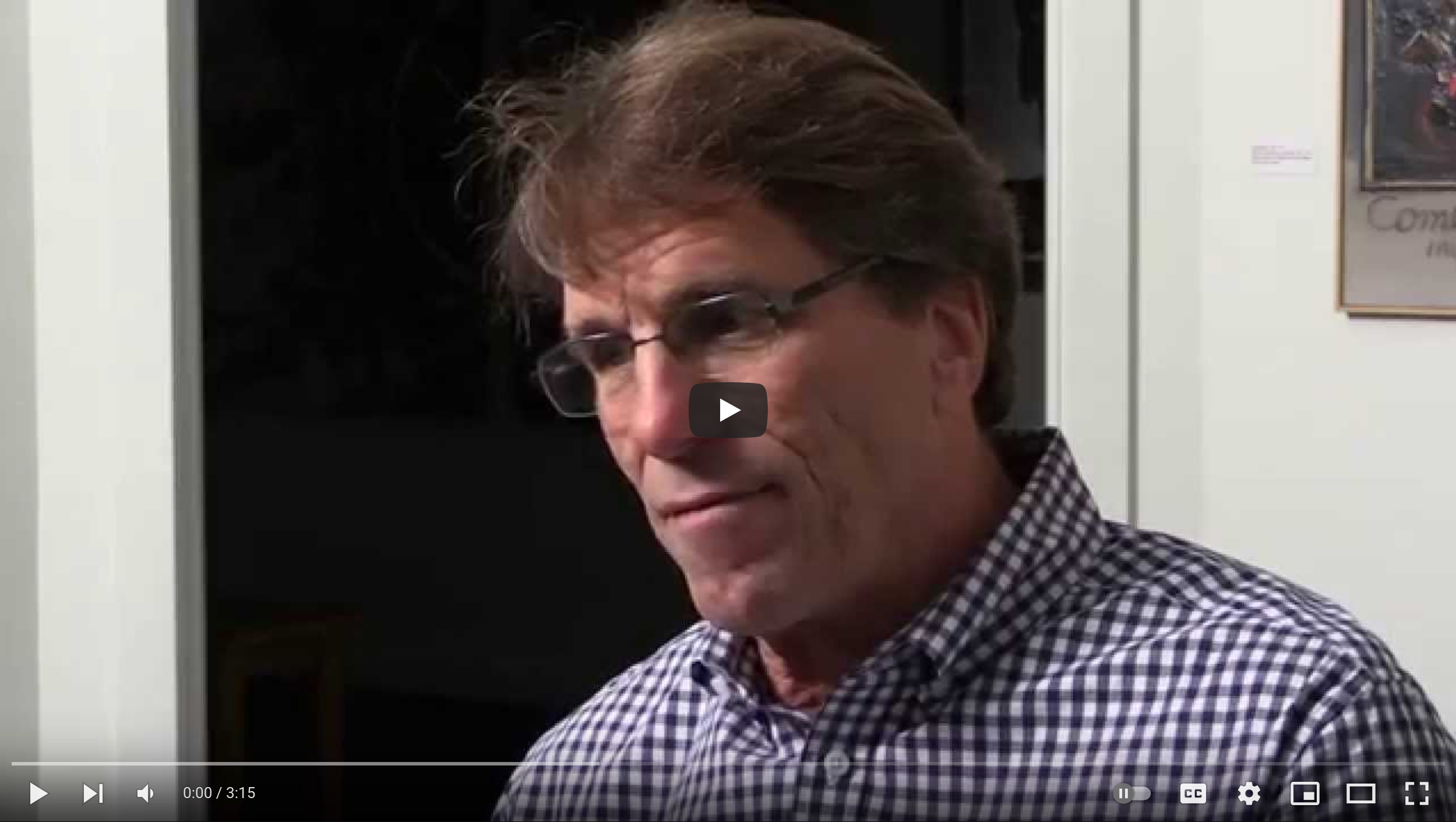News & Announcements
- Details
- Written by Joshua Wachtel
Chicago Public Schools (CPS), the third largest district in the U.S., is collaborating with more than two dozen Chicago-based organizations to end the school-to-prison pipeline by implementing restorative practices.
 Student explains the use of a talking piece during a circle at Umoja's 2013 Community Builders "Safe Spaces" summer internship.Ten years of grassroots organizing and practice has raised community awareness and helped demonstrate the effectiveness of restorative justice. Efforts have also led to policy changes, such as the revision of the CPS Student Code of Conduct and the city’s Juvenile Justice Code, which explicitly include restorative justice. Balanced and Restorative Justice, according to the CPS Student Code of Conduct include “ways of thinking about and responding to conflicts and problems by involving all participants to identify what happened, describe how it affected everyone, and find solutions to make things right.”
Student explains the use of a talking piece during a circle at Umoja's 2013 Community Builders "Safe Spaces" summer internship.Ten years of grassroots organizing and practice has raised community awareness and helped demonstrate the effectiveness of restorative justice. Efforts have also led to policy changes, such as the revision of the CPS Student Code of Conduct and the city’s Juvenile Justice Code, which explicitly include restorative justice. Balanced and Restorative Justice, according to the CPS Student Code of Conduct include “ways of thinking about and responding to conflicts and problems by involving all participants to identify what happened, describe how it affected everyone, and find solutions to make things right.”
- Details
- Written by Joshua Wachtel
Bullying is a great area of concern, especially in schools. In this video, IIRP Instructor Lee Rush talks about the way restorative practices dovetails with bullying prevention.
- Details
- Written by Joshua Wachtel
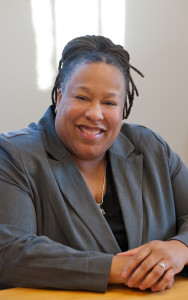 Dr. Stacey Miller, Director of Residential Life at the University of Vermont (UVM) since 2003, receives a lot of calls from people across the country inquiring about how they can bring restorative practices to their campuses. “I can feel the momentum swinging. It’s going to tip,” she says.
Dr. Stacey Miller, Director of Residential Life at the University of Vermont (UVM) since 2003, receives a lot of calls from people across the country inquiring about how they can bring restorative practices to their campuses. “I can feel the momentum swinging. It’s going to tip,” she says.
Miller was elected this month to serve on the IIRP Board of Trustees. Her enthusiasm for restorative practices has made her an effective leader of implementation efforts in her department and across campus. Now she will bring that leadership to the Board of the IIRP. “I am honored to have even been asked,” Miller says. “I am really humbled by the opportunity to participate and be a Board member.”
- Details
- Written by Joshua Wachtel
Featured
"A Philly first: No schools on Pennsylvania's 'persistently dangerous' list." Restorative practices are credited in the article for helping schools make this progress.
The NEA, the nation's largest teacher's union, hosts a talk, "School to Prison Pipeline - Restorative Strategies" with Kevin Gilbert, a member of the NEA's Executive Committee, Thursday, October 23, 2014, from 7-8 p.m. EDT.
The 6th International Juvenile Justice Observatory (IJJO) International Conference in Brussels, "Making deprivation of children's liberty a last resort: Towards evidence-based policies on alternatives," takes place in Belgium on December 3-4, 2014.
- Details
- Written by IIRP Staff
An invitation to students, parents, teachers and community organizations
Introduction to Restorative Practices – An Educational Workshop
Three dates: Sat., Oct. 18 or Sat., Nov. 8 or Sat., Dec. 20 (Each day runs 8:30 am–3:30 pm.)
Location: School District of Philadelphia Education Center, 440 N. Broad St., Philadelphia, PA 19130
- Details
- Written by Laura Mirsky
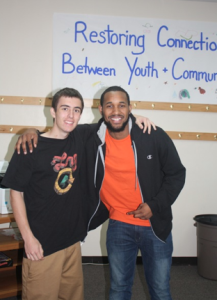 The restorative environment at Community Service Foundation and Buxmont Academy (CSF Buxmont) schools for at-risk youth enhances the effectiveness of the Aggression Replacement Training® cognitive-behavioral intervention program.
The restorative environment at Community Service Foundation and Buxmont Academy (CSF Buxmont) schools for at-risk youth enhances the effectiveness of the Aggression Replacement Training® cognitive-behavioral intervention program.
This is why the Aggression Replacement Training program is more effective with youth at CSF schools than with other Pennsylvania youth, theorizes CSF Buxmont Executive Director, Dr. Craig Adamson. “At CSF Buxmont schools, students are surrounded by a supportive treatment model that includes counseling and peer support, which creates many opportunities — all day long — to enrich what students are learning in the Aggression Replacement Training program,” says Dr. Adamson.
- Details
- Written by Laura Mirsky
This piece, by Laura Mirsky, the IIRP's assistant director for communications, was published originally by Educational Leadership Magazine, Summer 2014, Association of Supervision and Curriculum Development (ASCD). Download a pdf of the article from Educational Leadership.
When schools use restorative practices to build relationships and community, students’ attitudes change for the better.
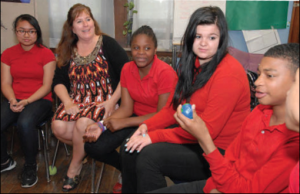 Students at Warren G. Harding Middle School in Philadelphia use a “talking piece” to indicate whose turn it is to speak during a restorative circle facilitated by teacher Denise James. (Photo by Danielle Marie Phil.)In April 2014, students at Warren G. Harding Middle School, in Philadelphia, Pennsylvania, had just finished a week of state testing, which they had found very stressful. Like all Harding’s teachers, 7th grade language arts teacher Denise James had her students sit in a circle and discuss the purpose of the tests and how they felt about having to take them.
Students at Warren G. Harding Middle School in Philadelphia use a “talking piece” to indicate whose turn it is to speak during a restorative circle facilitated by teacher Denise James. (Photo by Danielle Marie Phil.)In April 2014, students at Warren G. Harding Middle School, in Philadelphia, Pennsylvania, had just finished a week of state testing, which they had found very stressful. Like all Harding’s teachers, 7th grade language arts teacher Denise James had her students sit in a circle and discuss the purpose of the tests and how they felt about having to take them.
- Details
- Written by Joshua Wachtel
Higher Education
Higher-ed student conduct professionals are encouraged to attend the Association for Student Conduct Administration (ASCA) webinar on Restorative Justice in higher education, with the IIRP's Steve Korr, Michigan State University's Rick Shafer and Washington University in St. Louis's Molly Pierson.
- Details
- Written by Joshua Wachtel
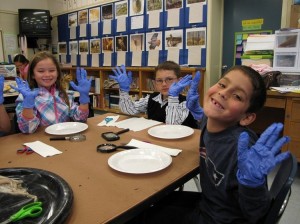 Students pose during "Squid Dissection Day" at Two Rock Elementary School, where Mike Simpson is currently superintendent and principalBack in the late 1990s, Mike Simpson, then a middle school administrator in South Burlington, Vermont, pioneered the use of Real Justice restorative conferences in schools. He also trained to be a trainer with the IIRP. At the time, the state of Vermont was experimenting with new ways to administer justice (see last month’s, “Serious Offenders Make a Change,” for more on Vermont’s cutting edge restorative programs and history), and Simpson was involved not only in conducting restorative conferences, but was training teachers, school counselors, DAs, state police and corrections officers to run them, as well.
Students pose during "Squid Dissection Day" at Two Rock Elementary School, where Mike Simpson is currently superintendent and principalBack in the late 1990s, Mike Simpson, then a middle school administrator in South Burlington, Vermont, pioneered the use of Real Justice restorative conferences in schools. He also trained to be a trainer with the IIRP. At the time, the state of Vermont was experimenting with new ways to administer justice (see last month’s, “Serious Offenders Make a Change,” for more on Vermont’s cutting edge restorative programs and history), and Simpson was involved not only in conducting restorative conferences, but was training teachers, school counselors, DAs, state police and corrections officers to run them, as well.
Recently Simpson got in back in touch to say that he had moved to the West Coast over a decade ago. He wrote, “RJ is beginning to get a toe-hold in Sonoma County where I work as a Superintendent/Principal” of Two Rock Elementary School in Petaluma, California. He is now in the process of helping to bring restorative practices to the 40 school districts of Sonoma County.
- Details
- Written by Joshua Wachtel
 In keeping with the restorative ethos of including all stakeholders in decision-making, the IIRP Graduate School sent a survey to prospective students worldwide to learn the best ways to deliver its course content. The overwhelming response was that students wanted to learn restorative practices, but they wanted more online and low-residency options so they could continue to live and work at home while they studied. Nationally, too, the trend in higher education throughout across the U.S. is toward more online and hybrid education. As the IIRP has developed opportunities for students to study restorative practices at the graduate level wherever they happen to live, a world-wide network of restorative learners and practitioners is being fostered.
In keeping with the restorative ethos of including all stakeholders in decision-making, the IIRP Graduate School sent a survey to prospective students worldwide to learn the best ways to deliver its course content. The overwhelming response was that students wanted to learn restorative practices, but they wanted more online and low-residency options so they could continue to live and work at home while they studied. Nationally, too, the trend in higher education throughout across the U.S. is toward more online and hybrid education. As the IIRP has developed opportunities for students to study restorative practices at the graduate level wherever they happen to live, a world-wide network of restorative learners and practitioners is being fostered.
Fully online courses, including introductory courses like RP 506, Restorative Practices: The Promise and the Challenge, allow students to connect with others around the world on their own time schedule. IIRP students who have taken the course talk about the advantages of working with diverse participants from different fields and places as far afield as the Netherlands, Canada, the Caribbean, South Africa, the U.S., Australia and Peru.

Restorative Works Year in Review 2023 (PDF)
All our donors are acknowledged annually in Restorative Works.

